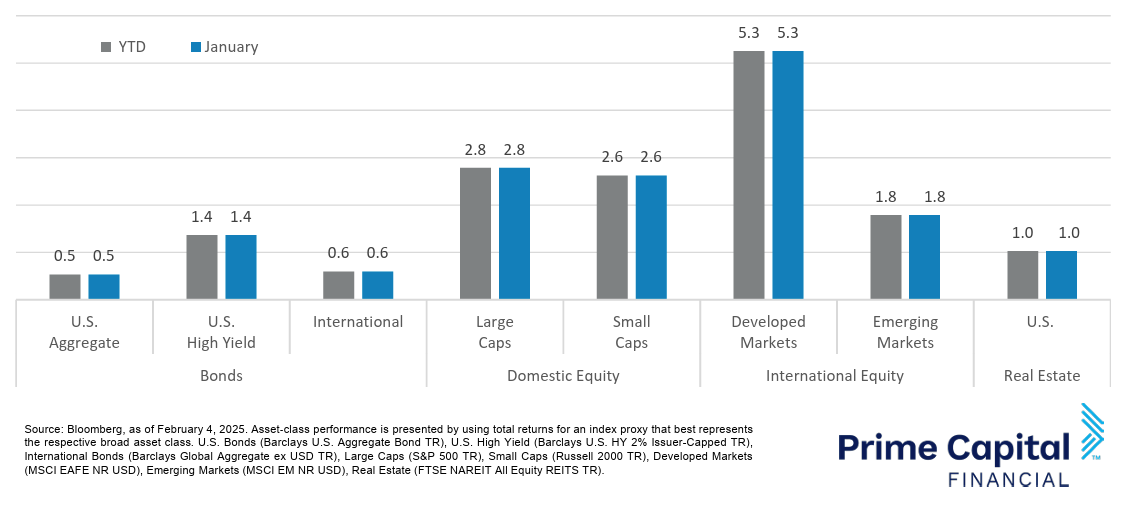Quick Takes
- Mag 7 Lags Stocks. Equity indices rose in January as the S&P 500 index increased 2.7%, the Dow rose 4.7%, and the Russell 2000 was up 2.6%. Despite a strong overall month, the Magnificent 7, which has driven stock gains over the last two years, lagged the broader indices falling 0.3% on the month.
- Inflation and Interest Rates. The 10Y treasury yield rose in the first half of January only to fall back to where it was to start the month at 4.5%. Inflation rose in December as the PCE index rose 2.6% year-over-year. Despite the higher headline number, core inflation remained flat at 2.8%.
- AI Spending Continues. Big technology companies will continue to spend on AI capital investment in 2025. Meta Platforms indicated that it would spend $60-65B on capital investment in 2025. Microsoft indicated that it would invest $80B in 2025 to continue its own data center capacity expansion.
- Trump’s Executive Orders. President Trump signed 45 executive orders by the end of January after taking office on January 20th. The executive orders made policy changes related to tariffs, immigration, energy, regulation, DEI, and the military.
Asset Class Performance
Large caps and small caps were nearly even in January. US stocks outperformed emerging markets, but lagged developed markets as tariff concerns, policy uncertainty, mixed earnings and inflation data drove markets. Domestic and international assets alike ended the month slightly higher including both fixed-income and equities.
Markets & Macroeconomics
Economic data indicated that the economy remained strong in December as job growth accelerated and some inflation measures came in below expectations. In the labor market, the US economy added 256K jobs in December, much better than the forecasted 165K that economists were anticipating. Private payroll growth was particularly strong with companies adding 223K jobs versus the 140K forecast for the month. One sore spot for job growth continued to be the manufacturing sector, which saw a decline in employment of 13K jobs during the month versus the projected addition of 5K jobs. Average hourly wages grew at a historically strong rate, but slightly below forecasted at 3.9% in December versus expectations of 4% growth. The labor force participation rate (LFPR) remained steady at 62.5% and the unemployment rate fell from 4.2% to 4.1%. In terms of inflation, all the major price indices changed as expected or increased less than forecasted. The Producer Price Index (PPI) came in 3.3% higher in December versus a year prior, below expectations of a 3.5% increase. Core PPI also came in below expectations at 3.5% versus the 3.8% forecast. CPI and PCE inflation showed similar easing as CPI inflation came in at 2.9% in December and PCE inflation came in at 2.6%, both in line with expectations. Core CPI and Core PCE showed even more inflation progress with Core CPI inflation coming in at 3.2% versus expectations of 3.3% and Core PCE inflation came in at 2.8%, in-line with expectations. Retail sales, meanwhile, lagged expectations in December, rising just 0.4% during the month versus the forecasted 0.6%, but grew faster than expected when excluding auto and gas sales. GDP growth in Q4 2024 was weaker than forecasted as well with the economy growing at an annualized rate of 2.3% versus the expected 2.6%. Fed Chairman Jerome Powell indicated that risks to inflation and unemployment are roughly in balance and that the Fed would not change its 2% inflation target when it reviewed policy in the summer. The FOMC held rates constant in January at 4.25-4.5%. Uncertainty around tariffs and other policy changes under the new administration has clouded the Fed’s outlook for the economy and rates and Powell and other Fed officials will need to consider these policy changes and their impacts before adjusting rates further.
Bottom Line: Inflation remaining elevated and policy uncertainty around immigration and tariffs continue to be barriers to interest rate cuts by the Fed. Meanwhile, the economy continues to see strong job growth, but retail sales and GDP growth were behind expectations to close out 2024. Manufacturing job growth continues to be weak and lag expectations despite strong growth elsewhere.
©2025 Prime Capital Investment Advisors, LLC. The views and information contained herein are (1) for informational purposes only, (2) are not to be taken as a recommendation to buy or sell any investment, and (3) should not be construed or acted upon as individualized investment advice. The information contained herein was obtained from sources we believe to be reliable but is not guaranteed as to its accuracy or completeness. Investing involves risk. Investors should be prepared to bear loss, including total loss of principal. Diversification does not guarantee investment returns and does not eliminate the risk of loss. Past performance is no guarantee of comparable future results.
Source: Sources for this market commentary derived from Bloomberg. Asset‐class performance is presented by using market returns from an exchange‐traded fund (ETF) proxy that best represents its respective broad asset class. Returns shown are net of fund fees for and do not necessarily represent performance of specific mutual funds and/or exchange-traded funds recommended by the Prime Capital Investment Advisors. The performance of those funds June be substantially different than the performance of the broad asset classes and to proxy ETFs represented here. U.S. Bonds (iShares Core U.S. Aggregate Bond ETF); High‐Yield Bond (iShares iBoxx $ High Yield Corporate Bond ETF); Intl Bonds (SPDR® Bloomberg Barclays International Corporate Bond ETF); Large Growth (iShares Russell 1000 Growth ETF); Large Value (iShares Russell 1000 Value ETF); Mid Growth (iShares Russell Mid-Cap Growth ETF); Mid Value (iShares Russell Mid-Cap Value ETF); Small Growth (iShares Russell 2000 Growth ETF); Small Value (iShares Russell 2000 Value ETF); Intl Equity (iShares MSCI EAFE ETF); Emg Markets (iShares MSCI Emerging Markets ETF); and Real Estate (iShares U.S. Real Estate ETF). The return displayed as “Allocation” is a weighted average of the ETF proxies shown as represented by: 30% U.S. Bonds, 5% International Bonds, 5% High Yield Bonds, 10% Large Growth, 10% Large Value, 4% Mid Growth, 4% Mid Value, 2% Small Growth, 2% Small Value, 18% International Stock, 7% Emerging Markets, 3% Real Estate.
Advisory products and services offered by Investment Adviser Representatives through Prime Capital Investment Advisors, LLC (“PCIA”), a federally registered investment adviser. PCIA: 6201 College Blvd., Suite#150, Overland Park, KS 66211. PCIA doing business as Prime Capital Wealth Management (“PCWM”) and Qualified Plan Advisors (“QPA”). Securities offered by Registered Representatives through Private Client Services, Member FINRA/SIPC. PCIA and Private Client Services are separate entities and are not affiliated.
© 2025 Prime Capital Investment Advisors, 6201 College Blvd., Suite #150, Overland Park, KS 66211.






